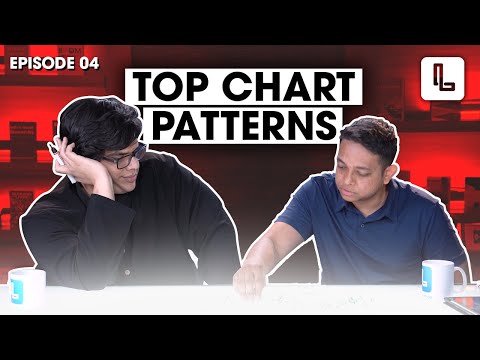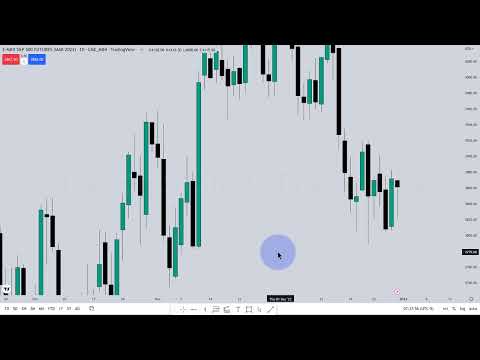How to Predict Stock Breakouts - Stock Trading Simplified #4

Welcome to another brand new episode of the basics of trading with Prateek and me. In the last episode we learned how stock prices discount everything. What are candlesticks. Different candlestick patterns and the psychology behind them.
In this episode we will zoom out and look at the bigger picture. We will observe how to read patterns that are made out of multiple candlesticks. We'll learn about support, resistance and the psychology behind all the various patterns.
But before we dive into it you know the drill just hit that like button and leave a comment saying Tanmay, only you are my life's true support. When you leave a comment it makes the algorithm recommend this video to more people. So if you hit the like button and leave a comment, it really helps the channel a lot. On that note, let's start today's episode. Welcome back to another episode. Okay so let's begin.
So, basically, as we know, trading and looking at stock prices is basically a bunch of people making decisions. Correct. And we're seeing supply demand happening, people are buying & selling at different places, and we are trying to understand, gauge demand. So far we looked at single candlesticks. Yes.
Let's now zoom out and look a bunch of candlesticks and see whether we can have demand and supply out there. Let's take a hypothetical example, I'll draw a line chart because it's easier. So, in this case let's suppose the market is here, it goes up, it comes down to a point, bounces back from the same point. Alright, now in this case, what's happening is, let's hypothetically imagine what the players are thinking. The first player, the trader who wanted to buy would be like, dude, the opportunity came twice, and I couldn't buy.
The investor probably thought the same thing as well. The other person is a guy who knew the market would go up, he read the news, he did all his analysis but didn't act by actually purchasing on this bounce. So a bunch of people now wanted to buy, but you know it didn't happen.
There's also a person who actually bought and says, I knew the market would go up. Right. Now, in this case let's say the market comes back to this position. People say okay, this position, let's suppose, let's suppose this is price, and this area, say 10,000 rupees. It's a nice round number, and psychologically, people think 10,000 seems like a nice round number, it’s repeatedly bouncing from here, the market must go up now, and for some reason everyone buys at the same point, it went up from 10,000, came down, went up again, and so on. I have got another opportunity to buy at this area again, people start buying and what happens, goes up again, prices go up.
Now this area is generally referred to as support. Right. This area. Notice I'm saying area, not point. It could be slightly lower, slightly higher.
Got it. But generally when prices come to this area so they, either prices bounce back from there in the past, which is these two, or it's a psychological round number Sensex hits 50,000, 30,000, Nifty hits 10,000, these are psychological areas that people say, okay, I think the market can bounce from here. Alright, that is support.
It's amazing how round numbers have this effect on psychology right like, yeah, of the buyer. The other opposite of that is resistance, same thing. So you notice but upwards, right, so market comes here and it falls down, and because it's fallen from that same area in the past, people say, this area has some resistance, so people are not letting it go above it. Correct. So you have this as your resistance area.
Right, we'll see some examples but basically this is the concept behind support and resistance. We have Harshad Mehta here and Manu Cobra here, I got it. Yeah, exactly. So basically when, when you get two points from where price bounces back, you can say that the area’s support, and the same thing happens on the other side, but those two points like over a week right.
Yes, that's a good question. So if you do this on a lower time frame like a 5 minute chart or a 10 Minute. This will not hold, less accurate, is less accurate. You do it on a higher time frame like a monthly or a weekly chart, it's more likely to be true and we'll see that going forward.
So you got it, support and resistance. So we have an example here on Bharti Airtel. Correct.
And notice I've taken monthly chart. It’s a pretty, like it's from 2007 to 2017. It a long time frame, that's why I said zoom out for support and resistance, and it's pretty clear right so you have one area here it's bounced from another bounce another bounce another bounce another bounce. So you can draw probably one line here, and one line somewhere here. So you can see that area, I should have touched those points but that area is your support area. This won’t go below 200-230.
Yeah, that's where demand comes in and they say hey, this seems really undervalued and either traders, or investors come in, I feel on a monthly timeframe, investors come in. Right. Because you have to push a large cap stock from an area so they say hey, we think, Bharti Airtel is probably valued at 300 or some large number, as soon as it comes to this 330, 340 area, they say okay, this is an area to buy, and that's where they come in and start buying, and then jumping from 200 and 230 to 330, is a 30% profit, it’s significant.
That's right. And if I scroll forward you will see that the market actually went up breaking resistance also. Yeah resistance also. Like, you can also see right like, you want to draw that yeah, go ahead, one minute, one minute. Yeah, go ahead.
So you can see that there is some sort of resistance at this, this price pair. Yeah, you're totally right. So, and at one point it broke that as well and then it consistently, it went way above that. Yeah, absolutely right. So your support & resistance is actually exactly as we drew here, right.
It looks exactly the same in this case. In this case, Bharti Airtel tried to break out, it failed, touched support again, went back up. So these are like demand and resistance zones. I guess my question is what are the signs that shows a stock is likely to break resistance and go higher or break support and go lower? Fair enough. So you're going ahead and trying to understand, what do I do with this information.
Correct. So the first step is to know that in this area there is a high likeliness of the market going down once it touches resistance. Got it.
Once it goes down, touches support, highly likely that it will bounce back up. Now how do you react to that, is your hypothesis, and you say okay, every time markets touch support, I'm going to buy it, and I want to test this hypothesis as a backtest and then you come up with a conclusion, and that becomes your system. Got it.
That's why this is a tool. Got it. Right. Understood. Like so as you can see, actually if we continue this Bharti Airtel right now, at the time of this recording is actually above resistance.
So what do you think is likely going to happen? It's likely going to fall. So it's broken resistance. Is broken resistance so maybe this resistance becomes the support for it, going forward.
That's super, did you read about this before. No, and also it ties into, this becomes the higher low for. So basically, support is a higher low right, essentially in the, the wider that you go, support starts acting as a, the support area starts acting as a higher low. Correct.
So what you're seeing is called something called polarity. Okay polarity basically means this, and I'll draw this again because I think it’s erased. This is our support area right. Now, that once this is broken so this is called a breakout. So, if this price goes above our resistance area, this portion now becomes support. Right, so now it's broken, this portion now becomes support.
So now if price comes back down it’s likely to bounce back and move up. Right, okay. This psychologically just becomes the support. It couldn’t increase beyond a point so it goes down, and goes back up again. There are investors who invested at the new support price, and now want to maintain their average buying price.
Correct. So when it reaches the new support they know it’s likely to increase and invest again. Perfect right, so this is polarity. So this is like a very interesting concept. Another example is once this price comes down, let's suppose this fails, the opposite happens price decreases beyond the support. Okay, this area, so price can then go here and it will fall, why? Because this area now becomes, the resistance.
Now I’ll ask you questions. So it's always like, some activity’s going on, when support and resistance is trying to break, it feels like there's gonna be some volatility. The traders gonna do shit, investors going to do something. So here now tell me, markets broke this resistance, I'll extend your drawing, what happened, did polarity happened here? Markets broke resistance. Yes it did because the resistance has now become the support.
Markets went up and had a new resistance, came down and the old resistance became support and went back again. Perfect. So that's support, resistance and how it inverses becomes polarity. It's like the stock leveling up. It is actually. It's like the stock leveling up, now I’ve entered a new round.
My previous high is now the low. It’s a cool thing, got it. Now I'll introduce a new concept, you already understand it.
I'm just giving a name to it, right, you already know it, when price breaks down from support. It's called a break down. Got it. Right, just something to remember, because people talk about a lot very obvious name. And when it breaks resistance, it’s break up. Stock’s break up.
Break out. So, in our Bharti example, this is a — This is a break... over. Breakout, breakout breakout, it's a breakout. So that's it right. Okay, Tanmay so I have a bank this time. Okay, IndusInd Bank, weekly chart. Okay.
I like higher timeframe charts, because it makes more sense. Just look at the right hand side of the chart, okay. Correct. This is. I’ll change this brush.
Okay, now can you draw the support resistance zone, okay this one is support zone. Excellent. Okay. And here ... hold up.. this is resistance zone. Perfect. So now the question is, if the market goes down from here what is that called? Break down.
And if it goes up? Break out. Excellent, let's see what happened. What is this? It's breaking out. Excellent and now this becomes what? This becomes the new support.
Excellent. So let's see what happened, you remember the weekly chart markets were at like 850, breakout was around 1000, do you see that? It's a round number, right? Yeah. It's like a round number around 1000 and went, Oh, okay, awesome, oh it went, it went further, it like, 1300. Right, it's like a 30% jump. Nice, the stock levelled up, nice.
Alright go further go further. Okay. All right, it's 1600 man.
We can see some resistance here, and this became the new support, at 1000 again, like this resistance, basically became the new support, then it broke out again, and wow, and it just kept travelling. Interesting right? Yeah and then here again it found. Can you draw, can you draw? So draw the support resistance. Here again we have the support area, here the resistance area, and it broke out again. Oh and then what happened. Interesting.
Then it went, it broke out, started facing some resistance here... at 2000. And from that resistance it came down to its support and went way lower than the support. So it failed, the breakout sort of failed. Like a fail, failed support. Failed breakout. Failed breakout. Correct.
Failed breakout because after it broke out, it wasn't able to convert its resistance into support. Yeah. Correct, and it wasn't so it came down to the previous support level, automatically, and it around 15-1600, and it got some support at the previous support level, and it tried breaking, it tested the resistance once again at 1800 price point, and the resistance pushed it back down again back to the support level at 15-1600. It’s better than cricket? Yeah. Wait what. And after that, then it broke down entirely.
Then it broke down from the previous support. So this is interesting, you know, draw the support resistance lines. Yes. Wait, I'll just. Okay go ahead. So support resistance broke out from here, a new resistance was formed, but it didn’t go up after hitting the support line, which means it broke down.
So one thing here, Tanmay, so you need two points. Correct. So we want a wave to make right, so you want something like market goes down goes up, goes down, there should be 3 points and we don’t have that here, so let’s not include this. But it was trying, yes it was.
It tried its best but didn’t work out so it came down, reached the support, and tried again to break the resistance, but it didn’t happen. Then it came down and support level further decreased. Let’s scroll and see. The new resistance level was here, it couldn’t break it, so oh my god, completely broke down all the way here. Yeah, perfect. So, excellent.
I feel bad for IndusInd. It really tried. But the interesting thing is, like there is like mass psychology where storytelling is hidden, not hidden actually it's right there in plain sight, and if you just know how to read it, you know what's happening. I would simplify this entire thing to be this right, markets came down you have support area, right, there's probably no significant resistance area and that just broke down right, okay. So that's it. Yeah, so when you look at the longer time frame than support & resistance appear clearer and even you take even more longer timeframe then you see a broader support & resistance.
Correct. Awesome. So a support is drawn on two points. Okay, so you have, it goes down bounces from the second point, once you have those two points, then you can draw your support. Got it.
So let's try, mark, I just go ahead in time a little bit. Okay, this is what happened over here. Do you see any support resistance here is your brush? I think this is support area.
Correct. Right. Yeah, this is a support area. Yeah, that's it. So you have point one, and then a second point and you can draw that line.
Correct. And then there was a lot of confusion and it tried to take support, and eventually what is this? This is broke down. That's it. Super simple right so don't when you're doing support resistance, don't look at the smaller moves an easy way is, zoom out a bit and just like blur your eyes, just spot two lines and draw a line that's an easy way to do it. Got it. Like how we learn candlestick patterns.
Correct. Can we also see patterns in support and resistance? Yeah, you can, which is a bunch, okay fine, we'll see how we can actually do support resistance and how patterns actually form with them. Okay, so I'll just remove this. I'll just draw at here.
So again, with patterns, the context of the trend is very important. What is the trend? So there are continuation patterns and reversal patterns. I'll show the reversal pattern on the right.
So now, in our story, the market was moving up. So it was a? Upward trend. Correct. And over here, the market goes up, comes down here, it's not come to our level here. Okay, so I'll just draw the red resistance zone. This resistance zone is working as it happened two times.
Now, in an uptrend, when you are able to draw resistance and it has happened twice, this is actually called, I have a prop here. It should make an M basically. Can you see that, the trend will look like this.
It will make a resistance, and then it will actually break down and fall. Okay, so like over here, market, you got this you got point number one, point number two, and then this breakdown happens. This is called a double top. Got it.
It is a reversal pattern, it was an uptrend, did a double top, and will now fall. Tried twice and now it’ll fall. Yeah. Notice, in this case, the support area straightaway breaks down.
So generally what people do is they say okay once this is formed, the confirmation of this is as soon as support breaks I know it looks like the double top is going to form and the reversal is going to happen right. It looks like that. It looks like that. But what if there’s double bottom, that it reaches here, then it will go up again right, yeah actually, let's continue this conversation in that direction. So, now another thing can happen, and I will remove this, Yes, M becomes W. When there’s W, as you might have guessed market’s coming down, touches support twice, and break the resistance.
Is it a rule that if it touches support twice, then it must break? No, actually. Like, this is the problem with chart patterns. If instead of twice, it touches support thrice, then it’s called triple top, right.
So that's one big problem with patterns, someone’s seeing double, someone’s seeing triple, there is a lot of ambiguity. So generally quantitative traders right, will not use patterns because defining it in its an exact form is very difficult. Right, but this is something as a trader you should know exists, but usually in a system and all it's not usually used.
Got it. Yeah, but for context it's important, so let's just understand how double bottom works. Okay.
So the market does this goes up, comes down here again, and then goes up here. And this is beautiful right because you got your support area, right, and your resistance broke, and you now have a double bottom, double bottom. Right.
So, generally speaking, these patterns work because support and resistance is working, base is the same. Correct. Got it. Okay let's see an example now, I have Tech Mahindra and Tech Mahindra daily chart is here. First question. What trend is this? This is an upward trend.
It's pretty simple. Over here we have the market, can you see any support or resistance here? This is resistance area and this is broad support area. Make sense.
Now question, it touches here twice, double top, especially if it breaks the support, double top is said to be confirmed. Okay, let's see what happens, it broke. So double top exists, now this is interesting, look at that from 820 ish, little more actually 830, it's now like 660, actually went till 600. That's what a double top is, basically it's a reuse of just resistance, and then break down, that's where it is. Got it. So this is Tata Motors, you know, Tata Motors right? Yes.
They make cars. This is a weekly chart. Very simple, I'll zoom in, first tell me, what sort of trend is this, and do you see a double bottom? This is downward trend. Got it. Can see double bottom here. Perfect.
He got support twice. Yeah, just two points. Now, as soon as this point is broken, is the double bottom confirmed? It’s the breakout here, here’s the resistance.
Just scroll forward. Oh, nice, got it. So that, that is basically what a double bottom is.
There’s support, resistance breaks, and it breaks out. Got it, cool. So you know, Tanmay, the problem with chart patterns in general, there are like a lot of chart patterns this was just like one or two. The problem is that it's very discretionary. Yeah, it’s slightly vague.
Not slightly, it’s fully vague, right, like I mean we can define this but like some people might see a double bottom which is a higher low, okay, I’ll just bend the line. So it's a little discretionary. It's not quantified. Correct. So that's where indicators come into the picture.
What are indicators? Exactly, and that's what we're going to learn in the next episode. In the next episode. On that note, you guys should go check out, hundreds of candlestick and chart patterns, most of which have been covered in the technical analysis module, 10 hours plus of content and 4 plus hours of practice. Check it out on LearnApp with the link in the description and get two months, extra access for absolutely free. And while you trade you need to analyze your stock fundamentals and history in depth, you can do that all thanks to ticker tape, check out the link in the description.
And before you begin trading one must have a D-mat account, so open your own D-mat account. All these links are available in the pinned comments.
2021-06-14 18:40


